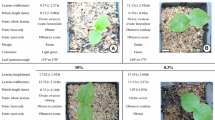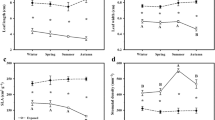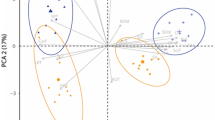Abstract
Reaction norms were determined in two natural populations of the perennial plantIris pumila from contrasting light conditions at two levels of photosynthetically active radiation (105 and 35 µmol m−2s−1). Seedlings developed from free-pollinated seed families sampled individually from 19 and 12 randomly selected clonal genotypes in an exposed and a shaded population respectively, were grown in a growth room using a mixed model nested factorial experimental design and scored for a number of phenological and morphological traits. Ambient light conditions significantly affected all of the juvenile traits measured. In both populations, relatively convergent norms of reactions were revealed for leaf appearance dates, as well as for leaf number, suggesting the importance of these traits for functional adjustment to prevailing light conditions. Reaction norms for morphological traits, however, were largely nonparallel, but although often crossing each other, a significant family-by-treatment interaction in the ANCOVAs performed was not detected for any of the traits measured, indicating a small amount of genetic variation for plasticity in these populations. The extent of plastic response to light availability was determined and expressed as an index that estimates the percentage change in a trait value from a high to a low light level. Evolutionary and ecological implications of the observed plastic variations are also discussed.
Similar content being viewed by others
References
Avramov, S., Tucić, B., 1995: Quantitative-genetic analysis of the juvenile traits inIris pumila. — Arch. Biol. Sci. (Belgrade)47: 117–125.
Bazzaz, F. A., 1979: The physiological ecology of plant succession. — Ann. Rev. Ecol. Syst.10: 351–371.
—, 1991: The response of annual plants to multiple stresses. — InWinner, W., Pell, E., Mooney, H. M., (Eds): The response of plants to multiple stresses, pp. 283–299. — San Diego, California: Academic Press.
Björkman, O., 1980: Responses to different quantum flux densities. — InPirson, A., Zimmerman, M. H., (Eds): Encyclopedia of plant physiology,12A, pp. 57–107. — Berlin, Heidelberg, New York: Springer.
Bradshaw, A. D., 1965: Evolutionary significance of phenotypic plasticity in plants. — Advances Genet.13: 115–155.
Cheplick, G. P., 1995: Genotypic variation and plasticity of clonal growth in relation to nutrient availability inAmphibromus scabrivalvis. — J. Ecol.83: 459–468.
Cooper, J. P., Edwards, K. J. R., 1961: The genetic control of leaf development inLolium. I. Assessment of genetic variation. — Heredity16: 63–82.
Dong, M., 1995: Morphological responses to local light conditions in clonal herbs from contrasting habitats, and their modifications due to physiological integration. — Oecologia101: 282–288.
Evans, G. C., 1972: The quantitative analysis of plant growth. Studies in ecology,1. — Oxford: Blackwell.
Falconer, D. S., 1990: Selection in different environments: effects on environmental sensitivity (reaction norm) and on mean performance. — Genet. Res.56: 57–70.
Fitter, A. H., Hay, R. K. M., 1981: Environmental physiology of plants. — London: Academic Press.
Fry, J. D., 1992: The mixed-model analysis of variance applied to quantitative genetics: biological meaning of the parameters. — Evolution46: 540–550.
Gavrilets, S., Scheiner, S. M., 1993: The genetics of phenotypic plasticity. V. Evolution of reaction norm shape. — J. Evol. Biol.6: 31–48.
Gomulkiewicz, R., Kirkpatrick, M., 1992: Quantitative genetics and the evolution of reaction norms. — Evolution46: 390–411.
Jong, D. de, 1990: Quantitative genetics of reaction norms. — J. Evol. Biol.3: 447–468.
Kendrick, R. E., Kronenberg, G. H. M., (Eds), 1994: Photomorphogenesis in plants. 2nd edn. — Dordrecht: Kluwer.
Köhlein, F., 1981:Iris. — Stuttgart: Ulmer.
Milliken, G. A., Johnson, D. E., 1984: Analysis of messy data.1. Designed experiments. — Belmont: Wadsvorth.
Platenkamp, G. A. J., Shaw, R. G., 1992: Environmental and genetic constraints on adaptive population differentiation inAnthoxanthum odoratum. — Evolution46: 341–352.
Randolph, L. F., 1955: The geographic distribution of European and eastern Mediterranean species of beardedIris. — Iris Year Book1955: 35–46.
SAS Institute, 1989: SAS/STAT user's guide, version 6. 4th edn. — Cary, N. C.: SAS Institute Inc.
Scheiner, S. M., 1993: Plasticity as selectable trait: reply toVia. — Amer. Naturalist:142: 371–373.
Schlichting, C. D., 1986: The evolution of phenotypic plasticity in plants. — Annual. Rev. Ecol. Syst.17: 667–693.
—, 1993: Control of phenotypic plasticity via regulatory genes. — Amer. Naturalist142: 367–371.
Schmalhausen, I. I., 1949: Factors of evolution: the theory of stabilizing selection. — Philadelphia: Blakiston.
Schmitt, J., 1993: Reaction norms of morphological and life-history traits to light availability inImpatiens capensis. — Evolution47: 1654–1668.
Sokal, R. R., Rohlf, F. J., 1981: Biometry. 2nd edn. — San Francisco: Freeman.
Stearns, S. C., 1992: The evolution of life histories. — New York: Oxford University Press.
Sultan, S. E., 1987: Evolutionary implications of phenotypic plasticity in plants. — Evol. Biol.21: 127–176.
—, 1995: Phenotypic plasticity and plant adaptation. — Acta Bot. Neerl.44: 363–383.
—, 1993: Phenotypic plasticity inPolygonum persicaria. I. Diversity and uniformity in genotypic norms of reaction to light. — Evolution47: 1009–1031.
Thompson, J., 1991: Phenotypic plasticity as a component of evolutionary change. — Trends Ecol. Evol.6: 246–249.
Trewavas, A., 1986: Resource allocation under poor growth conditions. A major role for growth substances in developmental plasticity. — InJennings, D. H., Trewavas, A. J., (Eds): Plasticity in plants, pp. 31–76. — Scarborough, North Yorkshire: The Company of Biologists.
Tucić, B., Avramov, S., 1996: Maternal effects on early juvenile traits inIris pumila. — Pl. Syst. Evol.201: 179–197.
—, 1984: Genetic distance and organization of isoenzyme variation in severalIris species. — Biosistematika10: 13–23.
—, 1988: Clonal diversity and dispersion inIris pumila. — Acta Oecol. Oecol. Pl.9: 211–219.
Via, S., 1984: The quantitative genetics of polyphagy in an insect herbivore. II. Genetic correlations in larval performance within and among host plants. — Evolution38: 896–905.
—, 1993: Adaptive phenotypic plasticity: target or by product of selection in variable environment? — Amer. Naturalist142: 352–365.
—, 1985: Genotype-environment interaction and the evolution of phenotypic plasticity. — Evolution39: 505–522.
—, 1987: Evolution of genetic viability in spatially variable environment: effects of genotype-environment interaction. — Genet. Res.49: 147–156.
Whalley, D. B., McKell, C. M., Green, L. R., 1966: Seedling vigor and the early nonphotosynthetic stage of seedling growth in grasses. — Crop Sci.6: 147–150.
Zhivotovsky, L. A., Marcus, F. W., Bergman, A., 1996: On the evolution of phenotypic plasticity in a spatially heterogeneous environment. — Evolution50: 547–558.
Author information
Authors and Affiliations
Rights and permissions
About this article
Cite this article
Pemac, D., Tucić, B. Reaction norms of juvenile traits to light intensity inIris pumila (Iridaceae): A comparison of populations from exposed and shaded habitats. Pl Syst Evol 209, 159–176 (1998). https://doi.org/10.1007/BF00985227
Received:
Revised:
Accepted:
Issue Date:
DOI: https://doi.org/10.1007/BF00985227




